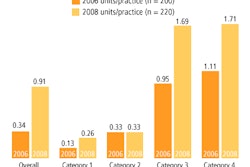The French dramatist Jean Cocteau stated, "We must believe in luck. For how else can we explain the success of those we don't like?" But why rely on luck, or worse yet, the goodwill of hospital administration, when it comes to obtaining or renewing your radiology group's exclusive contract, especially one with substantial hospital financial support?
Many groups unthinkingly subject themselves to a high degree of risk by not taking advantage of the years of time before the new contract term to develop and set in motion their strategy for renewal. Instead, they wait until they have nine or fewer months before the new contact term to begin negotiating with their partner facility.
It might be possible to achieve mediocre results without proper preparation, but no group should be aspiring to mediocrity, especially in tougher economic times when hospital financial support is more important than ever in retaining and recruiting highly qualified radiologists.
Success in these times requires thorough preparation and positioning. Thorough preparation requires far more than reviewing the current agreement and doing a few months, or even a year, of planning. It requires an integrated series of thoughts and actions to position the group for an optimal result.
Achieving a highly favorable exclusive contract, for example, one including multimillion dollar per year financial support, requires a strategy that unfolds tactics over a multiyear period. It requires coordinating exclusive contracting strategy with the group's overall business strategy. And it requires coordinating various contracting substrategies and their ensuing tactics with the group's exclusive contracting strategy. Many of these strategies and tactics have substantial -- but to the uninitiated, largely unrecognized -- effects on the resulting contract.
There are many common fallacies concerning negotiation, especially in terms of obtaining significant financial support. Some "experts" believe that the issue is as simple as making a presentation that states that financial support is warranted. Or worse yet, they take the position that because other groups get support, we should too.
There's also a common misperception that negotiation is like chess, but that's far from the case. If you must think it's like a game, then it's more like three dimensional tic-tac-toe, with a set of three boards stacked on top of each other. The moves occur in at least all three dimensions of physical space -- "at least," as negotiation also involves a fourth dimension, time, as well as a fifth dimension, the mind of your opposition.
In reality, game theory is flawed in application to complex, actual negotiation: Game theory requires that there be a set of rules. Negotiation often plays out, like life in general, with rules being broken and with new rules being made up all the time.
Case studies
Let's look at two examples based on real-life situations -- one in which a group takes the path well traveled toward the precipice and the other in which a group seeks to control its destiny.
Pursuant to an exclusive contract, Community Imaging (not its real name) has been providing all radiology services at a large community hospital for more than a decade. Extremely loyal to the hospital and its medical staff, the group's radiologists' incomes have been slipping for years even though their workload has increased.
Over the past 18 months, the group's leaders have been meeting with the hospital's administration in an unsuccessful attempt to get stipend support. Nonetheless, they continue to provide services as usual and to argue, in essence, that because groups at other hospitals receive stipends, they should too.
Even though only a few months remain on their current exclusive contract, they insist on continuing the same course of action: Relying on the advice of a valuation consultant, they persist in presenting yet another proposal to the hospital demonstrating that they are being compensated below market level and that similarly situated groups receive stipend support.
Although it's absolutely true that presenting evidence of other groups receiving support, as well as data concerning the discrepancy between the group physicians' earnings and those of the market, are central to the issue of a fair market value analysis -- a key issue in arriving at the amount of stipend support -- it is wholly ineffectual as a strategy to move the hospital off its position of refusing to discuss financial support at all. Without the proper positioning, the negotiation is over.
The second case involves a group that we'll refer to as to Memorial Imaging. Memorial has been providing, pursuant to an exclusive contract, all radiology services at a large hospital for many years.
The group's physicians were working harder and harder each year for less and less money. Memorial Imaging was having extreme difficulty recruiting radiologists to replace a recently retired member, and there was fear that one or more of the remaining physicians would soon depart.
Over a recent period of several years, Memorial had received a token amount of medical director stipend support: approximately $50,000 per year. The hospital was not interested in discussing any other stipend support.
Memorial Imaging implemented a multiyear process of positioning the group to obtain a strengthened bargaining position leading to greater independence and increased financial support. Elements of the process included acquisition of data and intelligence, control of publicity, creating bargaining leverage, framing the issues, and emasculating potential competitors.
By taking the time and exerting the effort to develop an overall strategy, to align specific elements of contracting strategy back with that overall strategy, and to implement tactics at each of the group, medical staff, community, and administration levels, Memorial Imaging positioned itself such that the renewal brought it millions of dollars per year of stipend support over a multiyear term.
Yes, Memorial Imaging invested significant dollars to accomplish this result, but the return on investment was well over 1,000%.
Achieving spectacular contracting results requires that you take a holistic approach. In reality, there is no independent negotiating strategy; it's merely part of a larger overall group strategy. Contracting strategy is inexplicably linked to governance strategy, to the way in which the group relates to nonowner physicians, to the compensation plan, to the patient experience, to the manner in which it contracts with third parties, to the way in which it gathers billing data ... and on and on to every other element of its business existence.
This process has no relationship to the usual "benchmarking to best practices." Far too many groups are oblivious to the opportunities, and as a result, benchmarking leads to the mediocre.
Radiologists are facing severe challenges: increasing commoditization, competition from other medical specialties, and downward reimbursement, to name but a few. A "benchmarking" lemming still goes over the cliff -- he just gets there a bit faster than some of the others. Success, even survival, lies in running in the other direction.
By Mark F. Weiss
AuntMinnie.com contributing writer
January 15, 2009
Mark F. Weiss is an attorney who specializes in the business and legal issues affecting radiology and other physician groups. He holds an appointment as clinical assistant professor of anesthesiology at University of Southern California's Keck School of Medicine and practices nationally with the Advisory Law Group, a firm with offices in Los Angeles and Santa Barbara, CA. Mr. Weiss provides complementary educational materials to our readers. He can be reached by e-mail at [email protected].
Related Reading
Doing due diligence: What to consider in mergers with nonradiology groups, June 12, 2008
The best way to run your practice? Look to corporate America, April 3, 2008
CMS anti-markup rule sparks more questions than answers, March 17, 2008
Want to survive in a post-DRA world? Start talking, March 4, 2008
'Purchasing Capital Equipment,' Part 3 -- Equipment assessment, October 26, 2007
Copyright © 2009 Mark F. Weiss



















